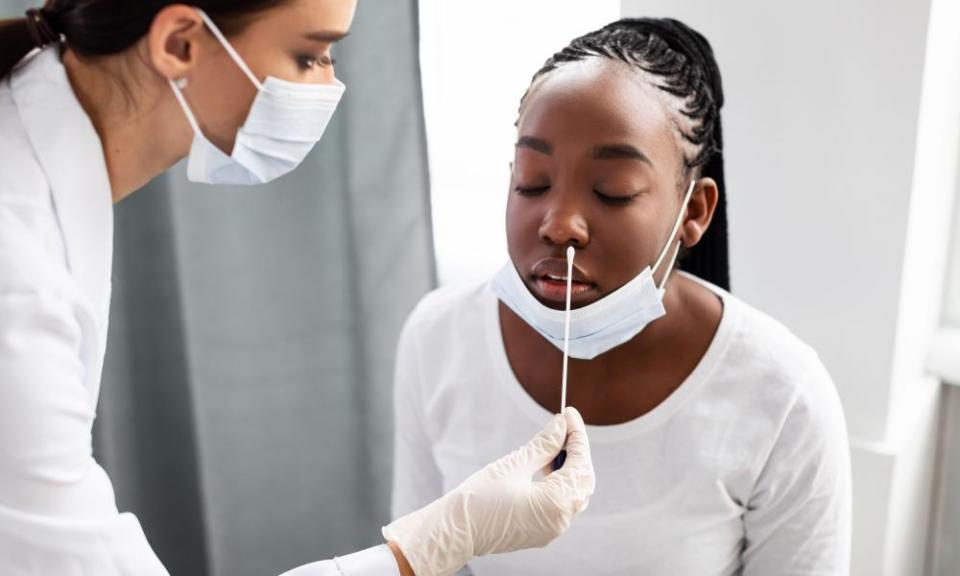Under the Skin review: US healthcare, racism and a terrible toll taken

Persistence, intelligence, a fierce devotion to the facts and an easy capacity for outrage. These are the building blocks of great journalism and they are the virtues that have made Linda Villarosa one of our most important activist-journalist-authors for several decades.
Related: A Way Out of No Way review: Raphael Warnock, symbol of hope for America
Her latest book, subtitled “The Hidden Toll of Racism on American Lives and on the Health of our Nation”, is a culmination of her important work going back to 1986, when her story Nobody’s Safe in Essence was the first article about HIV/Aids published in an ethnic magazine.
That piece marked the moment Villarosa realized “that these kinds of stories would be my life’s work”. Americans have been benefiting from her persistence and intelligence ever since.
Her new book tells a horrifying story about all the reasons Black Americans have been mistreated by doctors for centuries, beginning with the idea propagated under the transatlantic slave trade that Black men had a “primitive psychological organization” that made them “uniquely fitted for bondage”.
Dr Samuel Cartwright of New Orleans went so far as to assert that the desire to escape was itself proof of a mental illness.
It has been common knowledge for centuries that Black people suffer worse health outcomes than whites in America. But American racism has been so virulent for so long, it took even Villarosa many years to reject the idea that poor choices by Black people were the main reason for their misfortune.
She writes: “As recently as 2016, a survey of 22 white medical students and residents … showed that half of them endorsed at least one myth about physiological differences between Black people and white people, including that Black people’s nerve endings are less sensitive than whites.”
When asked to imagine how much pain white or Black people experienced from getting their hands slammed in a car door, the students “insisted that Black people felt less pain, which made the providers less likely to recommend appropriate treatment”.
The proven facts are appalling: the racial disparity in infant mortality is “actually greater in the present day than in 1850, when Black women were human chattel”. African Americans aged 18 to 49 “are twice as likely to die from heart disease”. Black infants are more than twice as likely as white babies to die before their first birthday.
Like the white medical establishment, Villarosa assumed poverty had to be a key factor in these statistics. But as researchers became more sophisticated, they discovered that “babies of more educated, higher-income Black parents were still more likely to be born small compared to their white counterparts”.
In 1997, researchers developed nine questions to determine scientifically how much racism an individual has been subjected to, ranging from “people act as if they think you are not smart” to “people act as if they think you are dishonest”.
What the data proved was that while socio-economic status and education are relevant, “the lived experience of being Black in America regardless of income and education, also affects health”.
One proof came from a 1997 study comparing the birth weights of children from US-born Black people with the babies of African-born Black people and US-born whites.
“The infants of the immigrant women from Africa closely matched in size to the white, not the Black, US-born babies. In other words, despite the disadvantages they experienced by being brought up in poorer countries, “their newborns were larger and more likely to be fuller term than babies born to African American women”.
And then, “the grandchildren of the Caribbean and African immigrant women were born smaller than their mothers had been at birth”.
As a super high-achiever with access to excellent health, Villarosa was shocked when she herself had a baby with below-average body weight.
Some of the most depressing parts of the book are the stories about the persistence of racism at elite American institutions like Stanford University, where a talented Black pre-med female student was routinely dismissed by white classmates who assumed she was only there because of affirmative action.
The same student said her four-year residency starting in 2002 was “a toxic mix” of racism and sexism.
“If you were a woman who wasn’t traditionally feminine” or “a person of color … the mainly older white men who ran the residency treated you horribly.”
And yet Villarosa remains resolutely optimistic. When part of this book was first published in a different version in the New York Times Magazine, under the title Why America’s Black Mothers and Babies Are in a Life-or-Death Crisis, in 2018, she was thrilled when the then governor of New York, Andrew Cuomo, responded with a pilot program to expand Medicaid coverage for birth doulas, “citing the need to target racial disparities in maternal mortality”.
And even when the Covid epidemic arrived as she was writing this book, confirming her essential thesis about the inequitable treatment of Black people by the American healthcare system, Villarosa remained hopeful.
She writes: “Together, America’s racial reckoning and a pandemic that has exposed long-standing racial health inequality have thrown an accelerant on a slow-burning fire of awareness, forcing America to grapple with issues of race and justice.”
Villarosa’s unquenchable faith in the power of journalism makes her a worthy successor to another famous muckraker, Ida B Wells, whose fearless journalism focused a nation’s attention on the horrors of lynching more than a century ago.
This book uses the same kind of ferocity to attack the persistent racism that infects the healthcare system in America.
Under the Skin: the Hidden Toll of Racism on American Lives and on the Health of Our Nation is published in the US by Doubleday Books

 Yahoo Movies
Yahoo Movies 